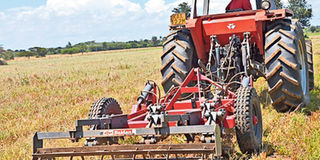Machines you need for large scale conservation farming

A tractor in a farm in Laikipia. Regular use of disc ploughs and harrows over a period of years does not protect the soil for future generations. PHOTO | BRIAN OKINDA | NMG
What you need to know:
- Fergus Robley, the managing director of Farm Machine Distributors (FMD), noted that the common practice of using disc ploughs to invert the soil normally results in unnecessary moisture loss.
- Preparing soil with a chisel plough, or deep subsoiler, he noted, protects moisture and preserves surface trash while providing the necessary aeration and soil shattering under the surface.
- For minimum tillage, a farmer needs a good 4WD tractor, a subsoiler, a sprayer in good working condition and a planter that is set up correctly to give the necessary plant population
For good minimum tillage practices, one must involve new farm implements to prepare land, including a chisel plough or subsoiler and a crumbler roller.
Fergus Robley, the managing director of Farm Machine Distributors (FMD), noted that the common practice of using disc ploughs to invert the soil normally results in unnecessary moisture loss.
“Following up with a disc harrow gives further residual moisture loss along with soil degradation. This method makes a dry seedbed with poor soil structure and results in crop yield limitations.”
“In contrast, preparing land for cultivation with a chisel plough, or a deep subsoiler preserves moisture in the soil and allows for economical land preparation. Moisture in the soil is as good as money in the bank,” he added.
According to him, regular use of disc ploughs and harrows over a period of years does not protect the soil for future generations.
“The most common result that we see too often is severe rain and wind erosions. This is not only an eyesore, but leaves fields redundant for future food production”
Preparing soil with a chisel plough, or deep subsoiler, he noted, protects moisture and preserves surface trash while providing the necessary aeration and soil shattering under the surface.
“This retention of valuable moisture is comparable to that of a forest floor with fallen leaves on the surface which provides similar preservation of moisture by acting as an umbrella for the soil. One pass with a crumbler roller after working with the subsoiler leaves the land ready for planting,” he explained.
He added, “Clearing the necessary weeds for planting can be achieved by using a cultivator (mechanical method), or crop sprayer (chemical method) before planting. The latter usually giving better results,” he explained.
For minimum tillage, a farmer needs a good 4WD tractor, a subsoiler, a sprayer in good working condition and a planter that is set up correctly to give the necessary plant population.
“Calibration of sprayers and planters is key for successful farming. The best land preparation is achieved using a deep tine to penetrate the soil to a depth of 18 inches to overcome the mechanical hard pan that usually occurs at eight to 10 inches below the surface, which arises from years of disc ploughing and harrowing. Use of a subsoiler with a crumbler provides a level and favourable seedbed for planting.”
While minimum tillage cultivation is of great importance in dry low rainfall areas like Tharaka Nithi and Laikipia, Robley said it is important on every farm anywhere in Kenya.
“Embracing good farming techniques improves yields and profit for the farmer’s pocket. Low rainfall areas in Australia with less rain than Laikipia or Tharaka Nithi regularly have good harvests from conservation agriculture which is primarily about the preservation of soil moisture.”





